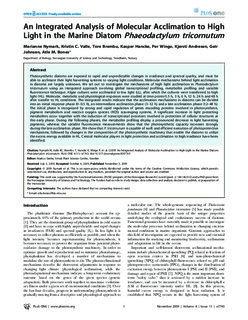| dc.contributor.author | Nymark, Marianne | |
| dc.contributor.author | Valle, Kristin Collier | |
| dc.contributor.author | Brembu, Tore | |
| dc.contributor.author | Winge, Per | |
| dc.contributor.author | Hancke, Kasper | |
| dc.contributor.author | Andresen, Kjersti | |
| dc.contributor.author | Johnsen, Geir | |
| dc.contributor.author | Bones, Atle M. | |
| dc.date.accessioned | 2015-10-29T13:35:11Z | |
| dc.date.accessioned | 2016-05-10T06:41:08Z | |
| dc.date.available | 2015-10-29T13:35:11Z | |
| dc.date.available | 2016-05-10T06:41:08Z | |
| dc.date.issued | 2009-11-03 | |
| dc.identifier.citation | PLoS ONE 2009, 4(11) | nb_NO |
| dc.identifier.issn | 1932-6203 | |
| dc.identifier.uri | http://hdl.handle.net/11250/2388872 | |
| dc.description.abstract | Photosynthetic diatoms are exposed to rapid and unpredictable changes in irradiance and spectral quality, and must be able to acclimate their light harvesting systems to varying light conditions. Molecular mechanisms behind light acclimation in diatoms are largely unknown. We set out to investigate the mechanisms of high light acclimation in Phaeodactylum tricornutum using an integrated approach involving global transcriptional profiling, metabolite profiling and variable fluorescence technique. Algae cultures were acclimated to low light (LL), after which the cultures were transferred to high light (HL). Molecular, metabolic and physiological responses were studied at time points 0.5 h, 3 h, 6 h, 12 h, 24 h and 48 h after transfer to HL conditions. The integrated results indicate that the acclimation mechanisms in diatoms can be divided into an initial response phase (0–0.5 h), an intermediate acclimation phase (3–12 h) and a late acclimation phase (12–48 h). The initial phase is recognized by strong and rapid regulation of genes encoding proteins involved in photosynthesis, pigment metabolism and reactive oxygen species (ROS) scavenging systems. A significant increase in light protecting metabolites occur together with the induction of transcriptional processes involved in protection of cellular structures at this early phase. During the following phases, the metabolite profiling display a pronounced decrease in light harvesting pigments, whereas the variable fluorescence measurements show that the photosynthetic capacity increases strongly during the late acclimation phase. We show that P. tricornutum is capable of swift and efficient execution of photoprotective mechanisms, followed by changes in the composition of the photosynthetic machinery that enable the diatoms to utilize the excess energy available in HL. Central molecular players in light protection and acclimation to high irradiance have been identified. | nb_NO |
| dc.language.iso | eng | nb_NO |
| dc.publisher | Public Library of Science | nb_NO |
| dc.rights | Navngivelse 3.0 Norge | * |
| dc.rights.uri | http://creativecommons.org/licenses/by/3.0/no/ | * |
| dc.title | An integrated analysis of molecular acclimation to high light in the marine diatom Phaeodactylum tricornutum | nb_NO |
| dc.type | Journal article | nb_NO |
| dc.type | Peer reviewed | nb_NO |
| dc.date.updated | 2015-10-29T13:35:11Z | |
| dc.source.volume | 4 | nb_NO |
| dc.source.journal | PLoS ONE | nb_NO |
| dc.source.issue | 11 | nb_NO |
| dc.identifier.doi | 10.1371/journal.pone.0007743 | |
| dc.identifier.cristin | 345730 | |
| dc.description.localcode | © 2009 Nymark et al. This is an open-access article distributed under the terms of the Creative Commons Attribution License, which permits unrestricted use, distribution, and reproduction in any medium, provided the original author and source are credited. | nb_NO |

